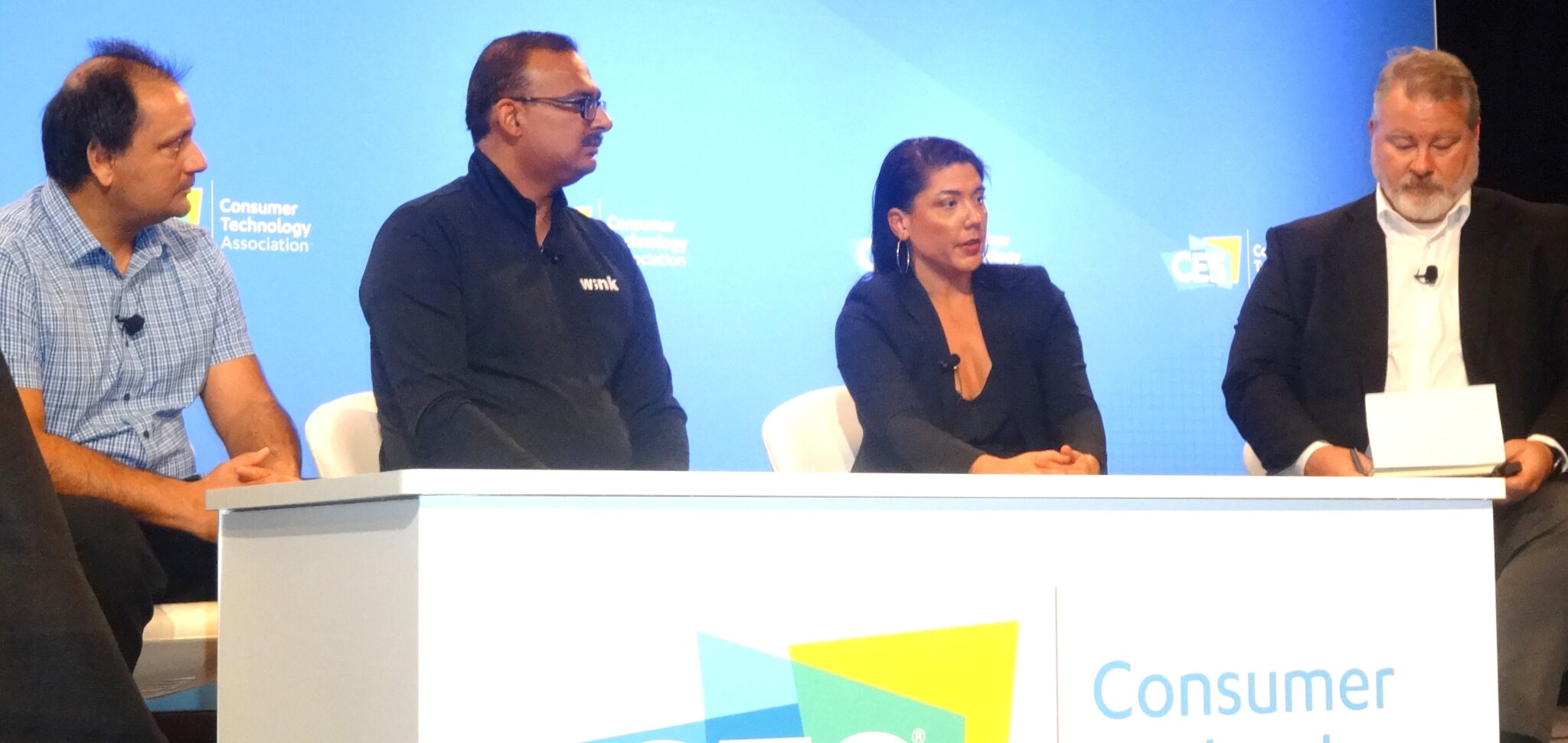A panel of shopping technology providers presented innovations that eliminate customer friction
Payment cards, passwords and user names will soon go the way of the horse and buggy, with shoppers able to initiate and complete a transaction simply by showing their face and saying “hello.” And that future has already begun to materialize, according to a panel of shopping technology providers who presented innovations that eliminate retail friction during a presentation, titled “frictionless retail,” at the recent CES show in Las Vegas.
Moderator Paul Gagnon, vice president of NPD Group, the Washington, D.C.-based research firm, began the session by defining frictionless retail as follows:
- Finding the right products quickly.
- Fast or no checkout.
- Secure and fast payment.
- Meeting the consumer where they are.
- Offering flexibility of service.
  |
| Moderator Paul Gagnon of NPD presents research on the growth of digital shopping during the CES conference. |
Each of the three panelists then presented a way that technology innovation has reduced customer friction.
Computer vision enhances self checkout
In the strictly physical space, AI-powered computer vision cameras now allow guests to check out multiple items in one transaction, as demoed on stage by panelist Mukul Dhankhar, CTO and founder of Mashgin, the Palo Alto, California-based manufacturer of a touchless self-checkout kiosk.
The system is already live in more than 1,800 locations, including c-stores, stadiums, airports and ski resorts.
Integrating physical, digital
Scan & Go — an app-free, contactless shopping technology from dentsu — integrates with a retailer’s e-commerce and loyalty platforms, noted panelist Valerie Vacante, vice president of solutions innovations for the Austin, Texas-based company.
Wink, a San Jose, California-based identity platform that uses biometrics, tackled the security challenge as it relates to shopping. In introducing the solution, panelist Deepak Jain, founder and CEO at Wink, said the assumption that frictionless and security don’t mix has now become dated.
“We decided to challenge that paradigm and figure out a solution for retailers and service providers and financial institutions that will allow them to not only offer a frictionless experience that is device-agnostic, that is omnichannel and that also provides the best in class security,” he said.
Wink uses both voice and face recognition to identify the user and allow them to check in and check out, be it in-store or online. There is no need for the user to have a password, user name or number, as with memory- or device-based platforms.
Applied either in-store or online, Wink’s audio greets the customer by name and guides them through ID verification, order process and payment.
Biometrics can also eliminate the friction a customer faces trying to prove he or she is a rewards member by showing a card or ID number or by scanning a QR code, Jain said.
  |
| Mukul Dhankhar, Deepak Jain, Valerie Vacante and Paul Gagnon discuss frictionless retail at CES in Las Vegas. |
What about retail shrink?
In addition to removing shopper friction, the panelists noted that their innovations also help address an issue that has been raised in response to autonomous shopping solutions — retail theft.
Dhankhar said Mashgin takes pictures of every transaction. If someone steals something, the system can provide pictures to the retailers.
In addition, biometric identification puts guests on alert that they are being recorded.
“If it is an unscrupulous customer, he knows that he’s being biometrically identified,” Dhanhkar said, which makes such a customer less likely to walk out with an unpaid item or to use a stolen credit card.
Vacante said there can also be an onsite employee monitoring the store, whose presence discourages theft.
Beyond shrinkage: inventory reduction
Reducing the amount of inventory in the showroom is yet another way to prevent shrinkage, the panelists noted, as well as helping to reduce inventory costs.
Vacante referenced a food retailer that limited shelf inventory and encouraged guests to view products online for home delivery.
“It helped the store alleviate inventory and provide that kind of assistance of getting the flavor you like,” she said.
Consumer privacy, affordability
As for the privacy concerns that biometrics sometimes create, the panelists said rising consumer acceptance of technology is addressing this issue.
“I think consumers are seeing this in all walks of life,” including usage in supermarkets, airports and connected cars, Dhankhar said. “Cameras are making things safer and more secure.”
As for affordability, a concern often raised by smaller retailers, Jain said newer technology should be more affordable with time.
Vacante agreed.
“We can work with a small-medium business into a very light-weight from a design perspective… We try to design all of these products in a way where there’s kind of a light-, medium- and heavy-weight option,” Vacante said. “For us, from a design perspective, we want to provide more accessibility — with more brands, more people, more consumers to engage.”
Digital shopping on the move
Meanwhile, digital shopping continues to grow.
Online sales grew from 44% in 2019 to almost 60% in 2020 and hasn’t declined much, Gagnon of NPD said. He echoed numerous other researchers in stating that the consumer preference for online commerce that took hold during the pandemic has not diminished. “People still prefer to purchase their products online,” he said.
Another change wrought by the pandemic is the tendency to use social media when seeking products to buy, he said. This past holiday season, 20% of all shoppers used social media when searching for gifts.
This, in turn, has led to a surge in direct-to-consumer sales.
“The brand (as opposed to the retailer) is the one making the transaction happen,” Gagnon said.
ELLIOT MARAS
Elliot Maras is the editor of Kiosk Marketplace and Vending Times. He brings three decades covering unattended retail and commercial foodservice | Source: Retail Customer Experience

